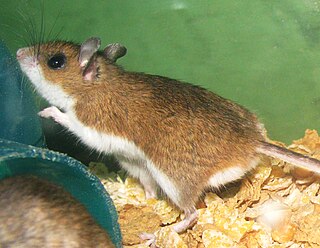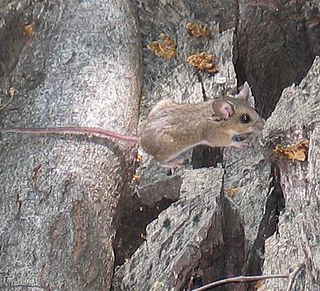
Peromyscus is a genus of rodents. They are commonly referred to as deer mice, not to be confused with the chevrotain or "mouse deer." They are New World mice only distantly related to the common house and laboratory mouse, Mus musculus. From this relative, Peromyscus species are distinguished by relatively larger eyes, and also often two-tone coloring, with darker colors over the dorsum (back), and white abdominal and limb hair-coloring. In reference to the coloring, the word Peromyscus comes from Greek words meaning "booted mouse". They are also accomplished jumpers and runners by comparison to house mice, and their common name of "deer mouse" is in reference to this agility.
Schmidly's deer mouse, is a recently described species of deer mouse from the mountains of western Mexico. It is part of the highly complex and well-studied Peromyscus boylii species complex. The uniqueness of Peromyscus from this area had long been suspected, but was only formalized in 2004 with the publication of its species description. The species was named in honor of David J. Schmidly, a mammalogist and former president of the University of New Mexico.

Peromyscus maniculatus is a rodent native to North America. It is most commonly called the deer mouse, although that name is common to most species of Peromyscus, and thus is often called the North American deermouse and is fairly widespread across the continent, with the major exception being the southeast United States and the far north.

The white-footed mouse is a rodent native to North America from Ontario, Quebec, Labrador, and the Maritime Provinces to the southwestern United States and Mexico. In the Maritimes, its only location is a disjunct population in southern Nova Scotia. It is also known as the woodmouse, particularly in Texas.

The pinyon mouse is native to the southwestern United States and Baja California in Mexico. These medium-sized mice are often distinguished by their relatively large ears. The range of this species extends from southern Oregon and Wyoming in the north, and extends south to roughly the U.S.-Mexico border, with a disjunct population designated as Peromyscus true comanche that occupies an area in the vicinity of Palo Duro Canyon in the Texas panhandle.
The Texas mouse is a species of rodent in the family Cricetidae. It is found in Arkansas, Kansas, Missouri, Oklahoma and Texas in the United States.

The brush mouse is a species of rodent in the family Cricetidae. It is found in mountainous areas of Mexico and the western United States at altitudes over 2,000 m (6,600 ft).

The California mouse is a species of rodent in the subfamily Neotominae in the family Cricetidae. It is the only species in the Peromyscus californicus species group. It is found in northwestern Mexico and central to southern California. It is the largest Peromyscus species in the United States.

The cotton mouse is a species of rodent in the family Cricetidae found in the woodlands of the Southeastern United States.
The nimble-footed mouse is a species of rodent in the family Cricetidae. It is found only in Mexico.

The oldfield mouse or beach mouse is a nocturnal species of rodent in the family Cricetidae. It is found in the southeastern United States on sandy beaches, in corn and cotton fields, and in hedge rows and open timber tracts. Coloration varies with geographic location; inland populations are generally fawn-colored, while coastal populations are lighter or white. The mouse eats seeds, fruits, and occasionally insects, and lives and raises its three to four young in a simple burrow. Weaning occurs at 20–25 days, and females may mate at 30 days of age. Predators are those that prey on small mammals. One individual lived in captivity for about five years. The mouse is of least concern to conservationists because it is abundant and widespread, and no major threats exist for the species as a whole, but several subspecies with small distributions are endangered or even extinct.
Ctenophthalmus pseudagyrtes is a species of fleas in the family Hystrichopsyllidae. It is widespread in North America, east of the Rocky Mountains, and is found mainly on small mammals. In Missouri, it has been recorded on the Virginia opossum, northern short-tailed shrew, eastern mole, raccoon, eastern chipmunk, Florida woodrat, prairie vole, woodland vole, white-footed mouse, including nests, marsh rice rat, hispid cotton rat, house mouse, and brown rat. Hosts recorded in Tennessee include the Virginia opossum, northern short-tailed shrew, eastern mole, eastern chipmunk, southern red-backed vole, rock vole, woodland vole, white-footed mouse, golden mouse, hispid cotton rat, marsh rice rat, and house mouse.
Stenoponia americana is a species of large flea in the family Hystrichopsyllidae. It is widespread in North America east of the Great Plains and is found mainly on rodents, notably deermice (Peromyscus) and voles (Microtus). In Missouri, it has been recorded on the fox squirrel, brush mouse, cotton mouse, prairie vole, woodland vole, and white-footed mouse. Hosts recorded in Tennessee include the northern short-tailed shrew, woodland vole, white-footed mouse, hispid cotton rat, marsh rice rat, and house mouse. In South Carolina, recorded hosts include the cotton mouse, hispid cotton rat, and marsh rice rat.
Polygenis gwyni is a flea that commonly infects the hispid cotton rat in the southern United States; it is also frequently found on other species ecologically associated with the cotton rat. Hosts recorded in South Carolina include the cotton rat as well as the Florida woodrat, cotton mouse, marsh rice rat, and brown rat.

Amblyomma maculatum is a species of tick in the genus Amblyomma. Immatures usually infest small mammals and birds that dwell on the ground; cotton rats may be particularly favored hosts. Some recorded hosts include:
Euschoengastia peromysci is a mite in the genus Euschoengastia of the family Trombiculidae. Recorded hosts include the cotton mouse and marsh rice rat in Georgia; the northern short-tailed shrew, northern red-backed vole, northern flying squirrel, rock vole, white-footed mouse, and deermouse in Tennessee; and northern red-backed vole, southern bog lemming, masked shrew, and eastern red squirrel in North Carolina, among others.
Euschoengastia setosa is a mite in the genus Euschoengastia of the family Trombiculidae that mostly parasitizes small rodents and lagomorphs. Recorded hosts include marsh rice rat in Georgia; the deermouse in Tennessee; and the eastern red squirrel in North Carolina, among others.
Pterygodermatites peromysci is an intestinal parasitic nematode in the genus Pterygodermatites of the family Rictulariidae.

Cuterebra fontinella, the mouse bot fly, is a species of New World skin bot fly in the family Oestridae. C. fontinella is typically around 1 mm long with a black and yellow color pattern. C. fontinella develops by parasitizing nutrients from its host, typically the white-footed mouse. C. fontinella has even been known to parasitize humans in rare cases. Individuals parasitized by C. fontinella will develop a large bump on the skin that is indicative of parasitization.









